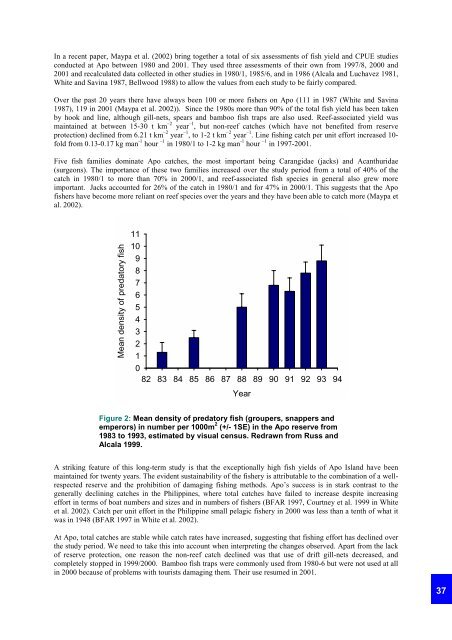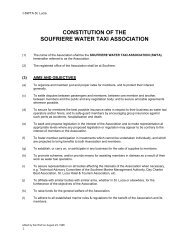WWF Cover photo - Soufriere Marine Management Association ...
WWF Cover photo - Soufriere Marine Management Association ...
WWF Cover photo - Soufriere Marine Management Association ...
Create successful ePaper yourself
Turn your PDF publications into a flip-book with our unique Google optimized e-Paper software.
In a recent paper, Maypa et al. (2002) bring together a total of six assessments of fish yield and CPUE studiesconducted at Apo between 1980 and 2001. They used three assessments of their own from 1997/8, 2000 and2001 and recalculated data collected in other studies in 1980/1, 1985/6, and in 1986 (Alcala and Luchavez 1981,White and Savina 1987, Bellwood 1988) to allow the values from each study to be fairly compared.Over the past 20 years there have always been 100 or more fishers on Apo (111 in 1987 (White and Savina1987), 119 in 2001 (Maypa et al. 2002)). Since the 1980s more than 90% of the total fish yield has been takenby hook and line, although gill-nets, spears and bamboo fish traps are also used. Reef-associated yield wasmaintained at between 15-30 t km –2 year –1 , but non-reef catches (which have not benefited from reserveprotection) declined from 6.21 t km –2 year –1 , to 1-2 t km –2 year –1 . Line fishing catch per unit effort increased 10-fold from 0.13-0.17 kg man -1 hour –1 in 1980/1 to 1-2 kg man -1 hour –1 in 1997-2001.Five fish families dominate Apo catches, the most important being Carangidae (jacks) and Acanthuridae(surgeons). The importance of these two families increased over the study period from a total of 40% of thecatch in 1980/1 to more than 70% in 2000/1, and reef-associated fish species in general also grew moreimportant. Jacks accounted for 26% of the catch in 1980/1 and for 47% in 2000/1. This suggests that the Apofishers have become more reliant on reef species over the years and they have been able to catch more (Maypa etal. 2002).Mean density of predatory fish1110987654321082 83 84 85 86 87 88 89 90 91 92 93 94YearFigure 2: Mean density of predatory fish (groupers, snappers andemperors) in number per 1000m 2 (+/- 1SE) in the Apo reserve from1983 to 1993, estimated by visual census. Redrawn from Russ andAlcala 1999.A striking feature of this long-term study is that the exceptionally high fish yields of Apo Island have beenmaintained for twenty years. The evident sustainability of the fishery is attributable to the combination of a wellrespectedreserve and the prohibition of damaging fishing methods. Apo’s success is in stark contrast to thegenerally declining catches in the Philippines, where total catches have failed to increase despite increasingeffort in terms of boat numbers and sizes and in numbers of fishers (BFAR 1997, Courtney et al. 1999 in Whiteet al. 2002). Catch per unit effort in the Philippine small pelagic fishery in 2000 was less than a tenth of what itwas in 1948 (BFAR 1997 in White et al. 2002).At Apo, total catches are stable while catch rates have increased, suggesting that fishing effort has declined overthe study period. We need to take this into account when interpreting the changes observed. Apart from the lackof reserve protection, one reason the non-reef catch declined was that use of drift gill-nets decreased, andcompletely stopped in 1999/2000. Bamboo fish traps were commonly used from 1980-6 but were not used at allin 2000 because of problems with tourists damaging them. Their use resumed in 2001.37



